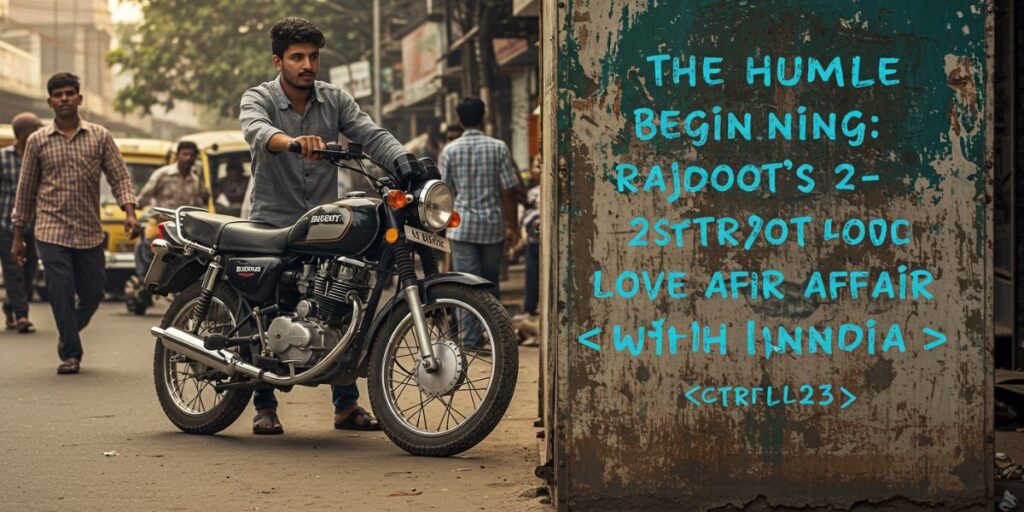You know what’s wild? There was a time when the thump of a Rajdoot bike could turn heads on every gully and highway across India. Back in the day—think late 60s to the 90s—Rajdoot wasn’t just a motorcycle brand. It was the ride. A no-nonsense, oil-smelling, gear-grinding beast that your dad, uncle, or neighborhood mechanic probably still dreams about.

Born out of a partnership between Escorts Group and Poland’s SHL, the Rajdoot 175 burst onto Indian roads in 1962. It wasn’t fancy. It wasn’t trying to be. But it was reliable, rugged, and ran like a bull in heat once you got used to the 2-stroke roar. And let’s not forget the iconic “Rajdoot GTS 175″—better known as the “Bobby bike” after Rishi Kapoor zipped around on it in Bobby (1973). That thing made motorcycles look cool to an entire generation.
Why Did Everyone Love It?
Because it worked. Whether it was city traffic or bumpy village roads, Rajdoot bikes didn’t complain. They were simple machines with fewer parts to go wrong, easy to fix, and tough as nails. Mechanics loved it. Riders trusted it. And the whole thing smelled like petrol-soaked freedom.
The Great Disappearance: When Rajdoot Vanished From Indian Roads
But then, somewhere around the early 2000s, something strange happened.
Rajdoot bikes started fading. Slowly. Almost like they knew their time was up.
The reasons? Let’s break it down:
- Environmental Crackdown: The 2-stroke engine, though a legend, wasn’t exactly eco-friendly. It guzzled oil and belched smoke like an angry dragon. As emission norms tightened, Rajdoot found itself choking—literally.
- Tech Gap: While other brands like Hero and Bajaj were flirting with fuel efficiency and sleek designs, Rajdoot was still stuck in a time capsule. And let’s be honest, nostalgia alone doesn’t sell when you’re filling up your tank twice as often.
- Lack of Innovation: The brand didn’t evolve. At a time when sporty designs and new-age engines were becoming the norm, Rajdoot remained stubbornly old-school. And while that worked for hipsters decades later, it didn’t help sales then.
Before we knew it, Escorts exited the bike business in 2001. Just like that—poof. No farewell, no last hurrah. The roads got quieter.
Plot Twist: The 2024 Rajdoot Comeback
Now here’s the fun part. Just when people had buried Rajdoot under a pile of retro Instagram posts and rusted engine parts, bam—2024 rolls in with a surprise.
Rajdoot is officially back. Not just as a collector’s wet dream, but as a full-blown, road-legal motorcycle for the modern age. And guess who’s behind this resurrection? A joint revival effort with Indian manufacturing talent and legacy-brand nostalgia marketing that actually makes sense.
No, this isn’t a soulless rebrand like slapping a sticker on a random bike. This is Rajdoot with a purpose.
New Rajdoot 2024: What’s Cooking Under the Tank?
Let’s talk specs. Because, yeah, style matters—but performance? That’s the real hook.
Here’s what the Rajdoot 2024 is packing:
- Engine: A 250cc single-cylinder, air-cooled engine tuned for mid-range torque. No more 2-stroke smoke, but it still gives that satisfying growl.
- Design: Retro-modern fusion. Think round headlamps, minimal panels, exposed frame, and that signature teardrop tank—updated with LED lighting and digital instrumentation.
- Brakes & Suspension: Disc brakes front and back, ABS (because safety matters now), and dual shock absorbers for that classic ride feel.
It’s like Rajdoot took a long nap, hit the gym, and came back with a new haircut and a smarter wardrobe.

Old-School vs New-School: How the 2024 Rajdoot Holds Up
So, how does the comeback kid compare to the OG?
| Feature | Rajdoot 175 (Classic) | Rajdoot 2024 |
| Engine | 173cc, 2-stroke | 250cc, 4-stroke |
| Fuel System | Carburetor | Fuel Injection |
| Brakes | Drum (both ends) | Disc (ABS-equipped) |
| Styling | Raw vintage | Retro-modern hybrid |
| Mileage | ~35 kmpl | ~45–50 kmpl |
| Emissions | High (BS0 vibes) | BS6-compliant |
Honestly, it’s not even a fair fight. The new Rajdoot isn’t trying to mimic—it’s building on legacy while giving you something rideable in 2024.
Whispers in the Garage: Is Rajdoot Going Electric?
Here’s where things get juicy. There’s a rumor doing the rounds—and you know how garage talk works—that Rajdoot might be testing an electric prototype.
No official word yet, but insider leaks suggest
- Battery Pack: Mid-range kWh lithium-ion
- Range: Around 120–150 km
- Design: Classic silhouette with hidden battery compartments
If this actually hits production, we’re talking about the first true heritage EV in India. Imagine riding a Rajdoot that hums instead of roars—but still turns heads. Kind of cool, right?
What’s It Gonna Cost You? Rajdoot 2024 Price in India
Let’s talk numbers—because at the end of the month, wallets feel heavier than dreams.
The expected Rajdoot 2024 price range is:
₹1.65 – ₹1.85 lakh (ex-showroom)
Now, is that worth it?
If you’re just looking for daily commute value, you might scoff. But if you’re craving style, nostalgia, and a machine with a story to tell, it’s a fair bet.
You’re not just buying a bike. You’re buying memories, attention, and that lovely feeling of owning something with a soul.
Retro Showdown: Rajdoot vs Royal Enfield
You knew this comparison was coming.
Royal Enfield owns the retro bike space right now, with models like the Classic 350 and Hunter 350 flying off the shelves. But here’s the spicy bit:
| Feature | Rajdoot 2024 | Royal Enfield Classic 350 |
| Engine | 250cc | 349cc |
| Vibe | Lighter, agile retro | Heavy, cruiser retro |
| Price | ₹1.7 lakh (est.) | ₹1.9 lakh (ex.) |
| Unique Factor | Rare nostalgia | Mainstream cool |
Rajdoot gives you what RE gave you a decade ago—a sense of being different. Not everyone’s riding one. Yet.
Who’s the Rajdoot 2024 Really For?
Let’s break it down. If you fall into any of these categories, this bike’s calling your name:
- The Nostalgic Millennial: You saw your dad ride it and always wanted a go.
- The Urban Hipster: You’re done with mass-produced cool. You want authentic cool.
- The Collector: You want one in your garage just for Sundays and admiration.
- The Commuter with Style: You want daily reliability and side-eye from jealous auto guys.
Rajdoot’s Road Ahead: Cult Revival or Temporary Buzz?

Here’s the thing: India loves nostalgia. But it’s also brutally practical. So, can Rajdoot survive the long haul?
It depends on three things:
- Quality Consistency: No one wants a legacy bike that breaks down every month.
- Product Evolution: An EV version or more color variants could be game-changers.
- Community Building: If Rajdoot clubs, merch, and riding culture start booming, then we’re looking at a movement, not just a product.
Either way, this comeback is more than a marketing stunt. It’s personal. For many, it’s a way to relive moments that smelled like petrol and sounded like freedom.
Conclusion
Rajdoot 2024 isn’t just about specs or price. It’s about how it makes you feel. That roar of the past, sharpened for today.
So if you’re someone who loves machines with a backstory—and doesn’t mind a few double-takes at traffic signals—this one might just be your next ride.



![10 Reasons Why Aavot.com Is Trending in 2025 [Must-Know Features & Benefits]](https://vyvymangaa.tech/wp-content/uploads/2025/05/Untitled-design-2025-05-22T095303.012-600x300.jpg)


